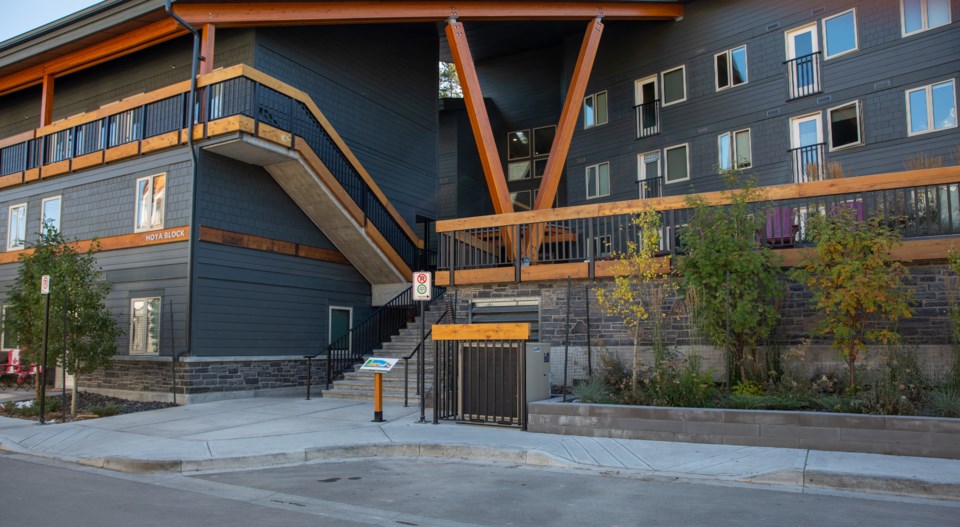BANFF – The Town of Banff is eyeing municipally owned lands, including existing green spaces, for affordable housing developments after scrapping plans for a below-market rental project on Cave Avenue.
Officials say the long-talked about Cave Avenue rental development is not considered viable because steep and unstable slopes on the six lots limit the number of units, the high construction cost per unit, and the annual income anticipated from the rental units.
“We've learned it’s a difficult site to build on for multiple reasons, mainly the slope, soils, and groundwater. As well, it’s not financially viable with an annual operating deficit of $1.2 million a year,” said Mayor Corrie DiManno.
“It is upsetting to walk away from this idea we’ve been dreaming of for so long and have invested time, money, and energy into, but at this point, it would be irresponsible to move forward with this specific project on Cave Avenue.”
In 2015, Parks Canada agreed to release 13 parcels of land to the Town of Banff for affordable rental housing. Seven lots were located on Coyote Lane and resulted in the 131-unit Tinu affordable housing development, and six other lots were located on Cave Avenue.
On Tuesday (May 23), council deferred any further direction on Cave Avenue until council has reviewed other potential land options that may be more financially feasible and sustainable, and able to accommodate construction of more units.
Council directed administration to return to a future council meeting with a list of proposed Town of Banff land parcels and conceptual massing for possible future housing development sites within the municipal boundary.
Sharon Oakley, the Town’s housing sustainability manager, said some municipally controlled land parcels could be used to add to Banff’s affordable housing stock, is land use bylaw re-designation was to be considered for these sites.
She said there are, for example, some parcels of land within the townsite currently zoned Public Service (PS) or Public Parkland (PP) that could be considered for rezoning to residential.
“This could allow for residential uses in these existing spaces, thereby giving the municipality additional opportunities to add more housing stock to the existing Banff Housing Corporation portfolio for both rental and ownership,” she said.
A change to the new management plan for Banff National Park, however, stipulates the Banff townsite reflects its national park setting by ensuring the net amount of land designated as PP and PE does not decrease from that existing as of Dec. 31, 2021.
“If any Public Parkland or Environmental Protection is changed to another zone, it must be offset by that correlating amount,” said Darren Enns, the Town’s director of planning and development.
"So that there’s no net loss of environmental protection of public parkland in the townsite, you would have to find a trade-off.”
DiManno said she reached out to Banff National Park superintendent Sal Rasheed last week to let him know the issue of Cave Avenue was coming before council May 23 and to inform him of her position on the matter.
“Of course, I won’t speak on behalf of him, but he was very understanding of the situation and respected the need to potentially change direction,” she said.
Moving on from Cave Avenue, the mayor said she is in full support of exploring any and all options for where the municipality can feasibly and sustainably build new housing for the community.
“I’m ready to reopen previously held conversations on all available Town-owned land parcels within the town boundary, including those that may require a land use bylaw re-designation,” she said.
“We need our next housing development to be bold and to ensure we can make as broad of a positive impact for as many Banffites as possible.”
For Cave Avenue, administration completed initial work specific to geotechnical investigation and slope stability analysis to determine the initial viability of the construction of affordable housing on this site.
The analysis determine the site would be able to accommodate 30 units on the six lots, which compares to 131 units that were accommodated on seven lots on the Tinu affordable housing development.
Following that analysis, administration developed a preliminary budget based on a 2023 estimated cost to build of $860/square foot for a total estimated project cost of $25.2 million or $842,000 per door.
Oakley said the proposed budget highlights the factors contributing to an increased cost to build, including post COVID-19 related construction issues, and the difficulty posed by the site slope and conditions.
“To ensure revenues would cover expenses, and not be tax-supported as per council’s direction, the Cave Avenue rental project is forecasting an annual operating loss of approximately $1.2 million,” she said.
The need for affordable rental housing in Banff has been identified for decades and the current estimated housing shortfall is between 700 and 1,000 units.




